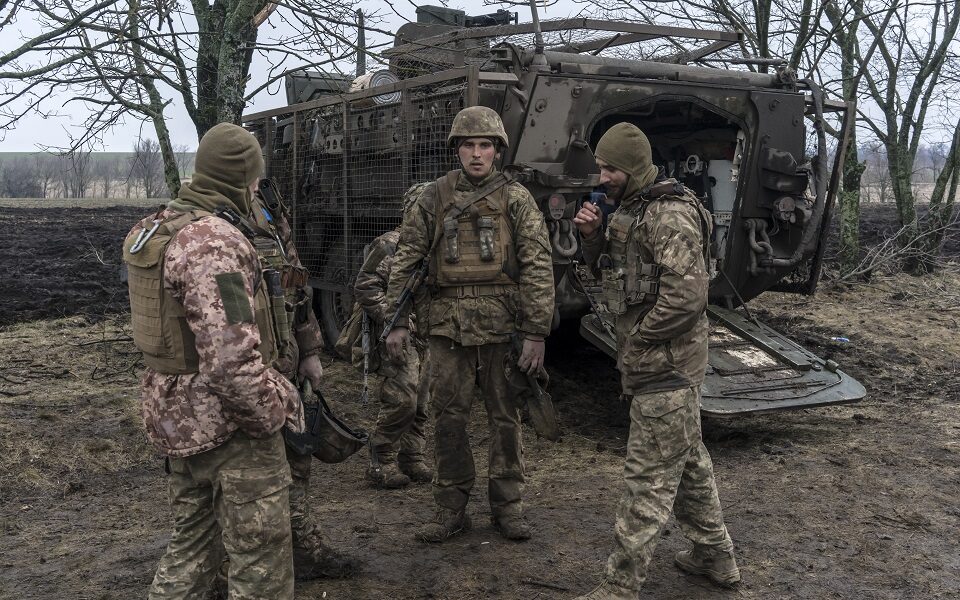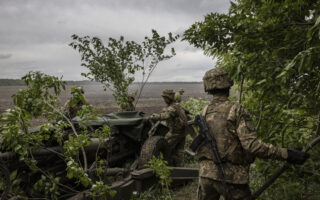Ukraine sees fight to retain small gains as crucial for national morale

Ukrainian soldiers spent hours ducking in trenches as artillery exploded around them, then dashed for the safety of an armored personnel carrier – only to be chased through the open rear ramp of the vehicle by an exploding drone.
“All I could see were sparks in my eyes,” said one of the soldiers, a sergeant, recounting how the pursuing drone blew up, leaving him and his team wounded but somehow still alive. He asked to be identified only by his first name, Oleksandr, according to military protocol.
Fighting on the plain in southern Ukraine’s Zaporizhzhia region, where Oleksandr’s vehicle was hit earlier this year, has raged for 10 months now in two phases: first with Ukrainian forces on the offense, and now on defense, as Russia escalates attacks on the area where Ukraine gained ground in last summer’s counteroffensive.
Military analysts have described Ukraine’s strategy as “hold, build and strike” – holding the line in the country’s southeast, replenishing its units with fresh troops and hitting back with long-range drones attacks on oil refineries and military logistics targets inside Russia.
In Zaporizhzhia, this has meant defending an area created by last summer’s counteroffensive, a 10-mile-deep semicircle that presses into Russian-held territory, forming a bulge. Soldiers describe ruined villages, trenches and fields that are a moonscape of shell craters.
At the southern tip of the semicircle lies the village of Robotyne. Ukraine recaptured it last summer, in the high-water mark of a counteroffensive that not only failed to achieve a breakthrough, but left the Russians in a strong enough position to start pushing back across the southern front.
Ukrainian forces occupying that bulge in the front line can be attacked from three sides, creating a dilemma: Abandoning that pocket would ease the pressure on them, but it would also signal a symbolic setback in the war, losing territory they gained last year at a high cost in casualties and destroyed weaponry.
Interviewed last week, soldiers who recently fought there described small sways in the front in both directions, and being badly outgunned by Russian artillery. Overall along the front line, Russia is firing seven times as many artillery shells as Ukraine, Gen. Ivan Havryliuk, a deputy minister of defense, told Ukrainian media Monday.
American weaponry that had been donated for the counteroffensive last year, including Stryker armored vehicles, has proved useful in protecting soldiers from these barrages now as they fight defensively.
But US politics now threaten the supply of arms. A package worth about $60 billion in military and financial assistance has been stalled in Congress for months over objections from some Republicans. The Biden administration last week announced it would send $300 million in stopgap military assistance using funds remaining from previously approved aid.
Russian forces attacked the pocket around Robotyne and areas nearby nine times over the past day, the general staff headquarters said Tuesday. When the Ukrainians captured the village last year, they pierced a main Russian anti-tank defensive line; now the Russians are trying to push them back and fill in that gap.
Like Bakhmut and Avdiivka, Robotyne, which had a prewar population of about 500 people, is now just ruins. Throughout the war, U.S. officials have repeatedly raised concerns that Ukraine was holding out too long in defending such places, committing soldiers and ammunition to cling to devastated towns with little strategic value.
But for Ukraine, the area around Robotyne remains worth fighting for, at least for now.
“At some point, symbolic becomes strategic,” Yurii Sak, a former adviser to the minister of defense, said of the fighting. Defending the gains of the offensive, he said, is “important for morale, it’s important for the support of the population, it’s important for the inner belief in our potential to win.”
The combat is also more costly in casualties for the attacking Russians than the Ukrainians in their defensive positions, Sak said. “As long as that calculus continues, it supports holding the ground,” he said. “It’s war, so casualties are inevitable on both sides.”
Russia is now on the offensive along the entire front line, which stretches in a 600-mile-long crescent from the Russian border in northeastern Ukraine to the southern Dnieper River. The Kremlin’s military has been using its advantage in ammunition, manpower and aviation.
Russia has swelled the ranks of its army by deploying squads of former convicts. It is buying artillery shells, missiles and exploding drones from North Korea and Iran to help replenish its supplies. Its planes avoid Ukrainian air defenses by dropping bombs from a safe distance that glide to their targets.
Just this year, Russia has dropped more than 3,500 glide bombs, Ukraine’s military said. Moscow’s electronic warfare instruments jam signals and scramble coordinates for Ukraine’s satellite-guided weapons.
The result has been a grinding advance that in February pushed Ukraine out of the small city of Avdiivka in the Donbas region of eastern Ukraine. Since then, Russia has been attacking with a combination of ground assaults and aerial bombing at seven points along the front, according to Ukraine’s general staff headquarters.
In the northeast, Russian forces are pushing through pine forests toward the city of Kupiansk on the Oskil River, seeking to reverse gains Ukraine made in a counteroffensive in the fall of 2022.
In the Donbas, a region of rolling hills dotted with coal mines and factories, Russia has been pressing along four lines of attack, seeking to exploit openings created by capturing Avdiivka. Ukrainian forces say they are holding defensive positions to the west of the city, though Russia has captured several small villages as it tries to advance.
Near the southern city of Kherson, Russia has been assaulting a Ukrainian outpost across the Dnieper River, on the eastern bank, in an area otherwise controlled by Russia. Russian forces assaulted the position three times Monday, the Ukrainian military said.
The position there is resupplied by boat and, like the bulge in the lines around Robotyne, it is precarious.
These fights are worthwhile, Ukrainian officials have said, because they cost Russia tens of thousands of soldiers killed and wounded, but there is skepticism in Washington.
“I understand the administration has been frustrated,” Evelyn Farkas, director of the McCain Institute, said, referring to the Biden administration.
“It’s unclear whether military decisions are purely military or influenced by political pressure or even direction,” she said.
At the training for Ukrainian troops fighting in the semicircular area near Robotyne, soldiers noted one advantage to the shift to a defensive strategy: fewer casualties. Russians now must leave their trenches to attack, while the Ukrainians are fighting from the cover of their positions.
Pulling back, said a private, also named Oleksandr, would merely leave Ukrainian troops fighting in other positions in similar conditions. “You need to defend every meter,” he said.
Still, it is a fierce fight in the south, over a landscape of open fields, muddy roads, ruins of farmhouses and countless blown-up vehicles, facing Russian forces on three sides.
Ukrainians have been fighting in the area long enough to give the positions they are defending nicknames like The Wheel, Silicon and Tank Trench.
Russian reconnaissance drones continually fly overhead, directing artillery or mortar fire on the soldiers. Aerial bombardments are common.
Small drones rigged with explosives and cameras buzz in regularly, chasing cars and sometimes people. The one that flew into Oleksandr’s armored personnel carrier in January wounded everyone inside, but all survived. Last week, he was training to return to the fighting in the same area.
This article originally appeared in The New York Times.






